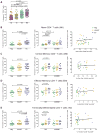Susceptibility to CD8 T-cell-mediated killing influences the reservoir of latently HIV-1-infected CD4 T cells
- PMID: 23846565
- PMCID: PMC3874432
- DOI: 10.1097/QAI.0b013e3182a1bc81
Susceptibility to CD8 T-cell-mediated killing influences the reservoir of latently HIV-1-infected CD4 T cells
Abstract
Background: HIV-1 establishes a lifelong infection in the human body, but host factors that influence viral persistence remain poorly understood. Cell-intrinsic characteristics of CD4 T cells, the main target cells for HIV-1, may affect the composition of the latent viral reservoir by altering the susceptibility to CD8 T-cell-mediated killing.
Results: We observed that susceptibilities of CD4 T cells to CD8 T-cell-mediated killing, as determined in direct ex vivo assays, were significantly higher in persons with natural control of HIV-1 (elite controllers) than in individuals effectively treated with antiretroviral therapy. These differences were most pronounced in naive and in terminally differentiated CD4 T cells and corresponded to a reduced viral reservoir size in elite controllers. Interestingly, the highest susceptibility to CD8 T-cell-mediated killing and lowest reservoirs of cell-associated HIV-1 DNA was consistently observed in elite controllers expressing the protective HLA class I allele B57.
Conclusions: These data suggest that the functional responsiveness of host CD4 T cells to cytotoxic effects of HIV-1-specific CD8 T cells can contribute to shaping the structure and composition of the latently infected CD4 T-cell pool.
Conflict of interest statement
None of the authors declare a conflict of interest related to this work.
Figures




References
-
- Trono D, Van Lint C, Rouzioux C, Verdin E, Barre-Sinoussi F, Chun TW, Chomont N. HIV persistence and the prospect of long-term drug-free remissions for HIV-infected individuals. Science. 2010;329:174–180. - PubMed
-
- Richman DD, Margolis DM, Delaney M, Greene WC, Hazuda D, Pomerantz RJ. The challenge of finding a cure for HIV infection. Science. 2009;323:1304–1307. - PubMed
-
- Wightman F, Solomon A, Khoury G, Green JA, Gray L, Gorry PR, et al. Both CD31(+) and CD31(-) naive CD4(+) T cells are persistent HIV type 1-infected reservoirs in individuals receiving antiretroviral therapy. J Infect Dis. 2010;202:1738–1748. - PubMed
Publication types
MeSH terms
Grants and funding
LinkOut - more resources
Full Text Sources
Other Literature Sources
Research Materials

